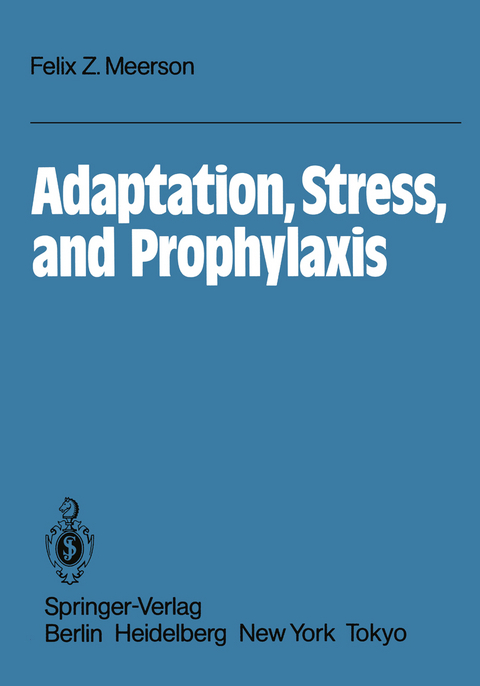
Adaptation, Stress, and Prophylaxis
Springer Berlin (Verlag)
978-3-642-61730-0 (ISBN)
1 - Basic Regularities of Phenotypic Adaptation.- Systemic Structural Trace: The Basis of Adaptation.- Interrelation Between Function and Genetic Apparatus: The Basis for Forming the Systemic Structural Trace.- Interrelationship of Cell Structures: A Parameter Determining the Functional Possibilities of the System Responsible for Adaptation.- Reversibility of Adaptation: Physiologic and Pathologic Deadaptation.- 2 - Role of Stress Reaction in Urgent and Long-term Adaptation.- Stress Mobilization and Redistribution of Resources.- Stress-enhanced Resistance to Hypoxia.- Lipotropic Effect of Stress in Biomembranes.- Antioxidant Effect of Glucocorticoids and the Influence of Synthetic Antioxidants on Urgent Adaptation to Physical Loads.- Post-stress Activation of Nucleic Acid and Protein Synthesis and Its Role in Forming Long-term Adaptation.- General Mechanism and Principal Stages of Phenotypic Adaptation.- 3 - Development of Adaptation to Hypoxia and Its Preventive Use.- Systemic Structural Trace and Principal Stages of Adaptation to Hypoxia.- 4 - Compensation, a Form of Adaptational Response of an Injured Organism.- 5 - Systemic Structural Trace: Foundation of Memory and Higher Adaptational Responses.- Relationship Between Memory and Adaptation.- Role of Emotional Stress in Forming Higher Adaptational Responses. Unity of Dynamics in Forming Conditioned Reflexes and Other Adaptational Responses.- Main Stages of the Development of Conditioned Reflex. Differences and Common Features of Higher and Simple Adaptational Responses.- Effect of Adaptation to Hypoxia on the Formation of Temporary Connections. Behavior and Brain Resistance to Harmful Factors.- 6 - Stress and Stress Damage.- Damaging Stress Situation and Pathogenesis of Stress Stomach Ulcers.- Pathogenesis of Stressand Ischemic Injuries of the Heart.- Stress: A Basic Etiologic Factor of Noninfectious Human Diseases. Its Role in the Origin of Ischemic Heart Disease and Tumors.- 7 - Adaptation to Stress Situations and Systems for Natural Prevention of Stress-induced and Ischemic Injuries.- Activation of the GABA-ergic Inhibitory System Under Stress as a Natural Mechanism for Preventing Stress-induced and Ischemic Injuries.- Blockade of Physiologic Effects of Calcium: Its Role in Preventing Ischemic and Stress Damages.- Role of the Adenine Nucleotide System and Its Product Adenosine in Preventing Energy Shortage and Limiting Adrenergic Effects.- Activation of the Prostaglandin System: A Factor for Preventing Stress and Ischemic Damages.- 8 - Antioxidant Factors in the Organism: A System of Natural Prevention of Stress-induced and Ischemic Injuries.- Antioxidant Systems and Action Mechanisms of Exogenous Antioxidants.- Antioxidant Protection of the Heart Against Hypoxia, Ischemia, and Reoxygenation.- Conclusion.- References.
| Erscheint lt. Verlag | 12.10.2011 |
|---|---|
| Übersetzer | J. Shapiro |
| Zusatzinfo | X, 330 p. |
| Verlagsort | Berlin |
| Sprache | englisch |
| Maße | 170 x 244 mm |
| Gewicht | 594 g |
| Themenwelt | Medizinische Fachgebiete ► Innere Medizin ► Kardiologie / Angiologie |
| Studium ► 1. Studienabschnitt (Vorklinik) ► Physiologie | |
| Naturwissenschaften ► Biologie | |
| Schlagworte | Adaptation • Präventivmedizin • Stress |
| ISBN-10 | 3-642-61730-1 / 3642617301 |
| ISBN-13 | 978-3-642-61730-0 / 9783642617300 |
| Zustand | Neuware |
| Haben Sie eine Frage zum Produkt? |
aus dem Bereich


